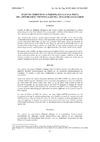Identificador persistente para citar o vincular este elemento:
https://accedacris.ulpgc.es/jspui/handle/10553/1110
| Título: | Eventos climáticos a pequeña escala y la pesca del atún blanco (thunnus alalunga) en las Islas Canarias | Autores/as: | Ganzedo López, Unai Arregi, Igor Sancristobal, Igor Castro, J.J. |
Palabras clave: | Atún blanco Pesca Anticiclones Canarias |
Fecha de publicación: | 2007 | Publicación seriada: | Collective volume of scientific papers - International Commission for the Conservation of Atlantic Tunas | Resumen: | Las capturas de atún blanco (Thunnus alalunga) en el Archipiélago Canario vienen determinadas por diferentes eventos meteorológicos que influyen en las condiciones oceanográficas del Archipiélago. Estos factores a su vez condicionan la presencia del atún blanco en las aguas canarias.
Tras analizar las capturas de atún blanco registradas entre 1965 a 2003, se observó que determinados eventos meteorológicos relacionados con la posición geográfica del centro barométrico del anticiclón de las Azores índice NAO, en este caso un índice NAO positivo, favorece la presencia de juveniles de esta especie en el área FAO 34. Sin embargo, la falta de relación entre las capturas en las islas canarias y el resto del área FAO 34, nos hizo suponer que ciertos eventos meteorológicos influirían, de modo diferente, en las capturas en las islas canarias.
En invierno del 2002 se registraron las capturas por unidad de esfuerzo (CPUE) diarias y la posición geográfica donde se efectuaron por parte de la flota artesanal de cebo vivo durante toda la costera y además se hizo un seguimiento de las condiciones océano-climáticos de la zona. A la inversa de lo que ocurre en el resto de área FAO 34, un índice NAO negativo facilitaría la entrada del cardumen, manteniéndose en las estructuras mesoescalares al sur de las islas. Catches of albacore (Thunnus alalunga) in the Canary Islands are determined by various meteorological events that influence the oceanographic conditions of the Islands. At the same time, these factors affect the presence of albacore in Canarian waters. After analyzing the albacore catches reported between 1965 and 2003, it was observed that certain meteorological events related to the geographic position of the barometric center of the Azores anticyclone NAO index, in this case a positive NAO index, favors the presence of juveniles of this species in the FAO 34 area. However, the lack of relationship between the catches in the Canary Islands and the rest of the FAO 34 area, made us suppose that certain meteorological events would influence, in a different manner, the catches in the Canary Islands. During the winter of 2002, the daily catches per unit effort (CPUE) were registered as well as the geographical position where these were taken by the artisanal baitboat fleet throughout the entire coast and a follow up was carried out of the oceanic weather conditions of the area. Contrary to what occurs in the FAO 34 area, a negative NAO index would assist in the entry of schools, remaining at the meso layer structures south of the islands. |
URI: | https://accedacris.ulpgc.es/handle/10553/1110 | ISBN: | 10215212 | Fuente: | Collective volume of scientific papers = Colección de documentos científicos. ICCAT. v. 60, n.2, pp. 527-539 |
| Colección: | Artículos |
Visitas
40
actualizado el 10-ene-2026
Descargas
34
actualizado el 10-ene-2026
Google ScholarTM
Verifica
Altmetric
Comparte
Exporta metadatos
Los elementos en ULPGC accedaCRIS están protegidos por derechos de autor con todos los derechos reservados, a menos que se indique lo contrario.
